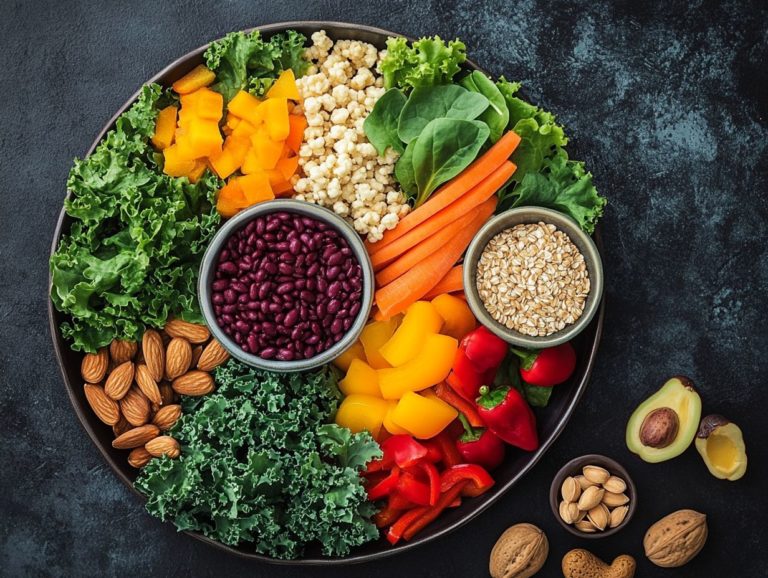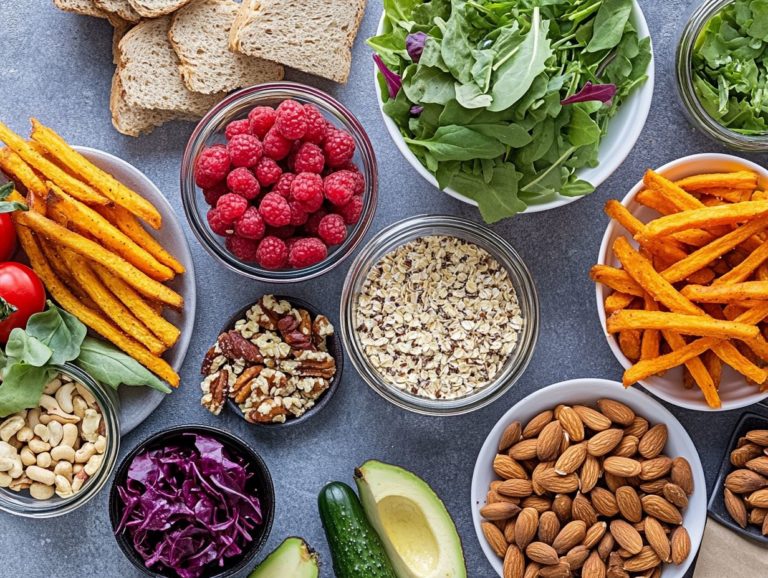How Do I Start a Low-Carb Diet?
Curious about the low-carb diet trend? This article delves into everything you need to know, from its definition and benefits to practical tips for getting started.
Explore the various types of low-carb diets, weigh their pros and cons, and learn how to effectively plan your meals.
You will discover common pitfalls to avoid and strategies that can help you maintain long-term success.
Whether your goal is weight loss or improved health, you will find valuable insights to guide your journey.
Contents
- Key Takeaways:
- Benefits of a Low-Carb Diet
- Types of Low-Carb Diets
- How to Get Started on a Low-Carb Diet
- Common Mistakes to Avoid
- Sticking to a Low-Carb Diet Long-Term
- Frequently Asked Questions
- 1. How do I start a low-carb diet if I am already used to eating a lot of carbs?
- 2. What are the benefits of following a low-carb diet?
- 3. Are there any restrictions on food groups when following a low-carb diet?
- 4. How do I know if a low-carb diet is right for me?
- 5. Can I still eat out while following a low-carb diet?
- 6. Are there any potential side effects of starting a low-carb diet?
Key Takeaways:

Start your low-carb journey today! Learn the basics and choose a diet that fits you best. Plan your meals and stay motivated for lasting success.
What is a Low-Carb Diet?
A low-carb diet is your ticket to reducing carbohydrate intake while embracing healthy fats and proteins. This supports your health goals, whether that means shedding pounds or managing insulin levels more effectively.
By cutting back on starchy vegetables and sugars, you can boost your energy and quell those pesky sugar cravings.
Incorporating non-starchy vegetables and nutrient-dense foods is essential for enhancing your overall well-being. With the right nutrition education and guidance from a registered dietitian, you can fine-tune your meal planning for effective weight management and health benefits.
This approach contrasts with traditional guidelines that often push for higher carbohydrate consumption, which can lead to erratic blood sugar levels and an insatiable appetite.
A low-carb diet invites you to savor whole foods like avocados, nuts, seeds, lean meats, and low-sugar fruits. It emphasizes nutrient density over empty calories.
Understanding carbohydrates’ role is vital; they are your primary energy source. However, excess carbohydrates can sabotage your weight loss efforts and cause sudden increases in blood sugar levels.
By prioritizing balanced meals that incorporate ample protein and healthy fats, you can enjoy sustained energy and improved satiety, paving the way for a healthier lifestyle overall.
Benefits of a Low-Carb Diet
Embracing a low-carb diet can offer you numerous benefits, such as substantial weight loss, improved management of diabetes, and a noticeable boost in energy levels.
This approach has become increasingly favored among those aiming to shed pounds and cultivate a healthier lifestyle. By prioritizing healthy fats and protein in your meals, you may find that your sugar cravings diminish and your insulin levels stabilize.
Weight Loss and Other Health Benefits
One primary reason you might consider adopting a low-carb diet is weight loss. Reducing your carbohydrate intake can effectively decrease body fat while promoting various health benefits, like improved energy levels and reduced sugar cravings.
This approach encourages you to increase your intake of healthy fats and proteins, along with a boost in fiber through non-starchy vegetables. This leads to enhanced satiety and overall well-being.
The mechanisms behind this weight loss are intricate, involving hormonal shifts that play a significant role in regulating your metabolism and appetite. When you cut back on carbs, your insulin levels decrease, facilitating fat breakdown and inhibiting fat storage.
Many people find psychological benefits as well, such as a newfound sense of control over their eating habits. Testimonials often highlight increased energy throughout the day and improved digestion, as focusing on whole foods enhances gut health.
Collectively, these changes not only support your weight loss goals but also contribute to a more vibrant lifestyle, demonstrating just how effective such dietary shifts can be.
Types of Low-Carb Diets

You will find a variety of popular low-carb diets, each with its distinctive characteristics and strategies for reducing carbohydrates.
Options like the Atkins diet, ketogenic diet, South Beach diet, Dukan diet, and Paleo diet cater to diverse dietary preferences. These diets focus on different food sources think healthy fats, proteins, and whole grains while promoting balanced meals that support sustainable weight management and overall health.
Ready to start your low-carb diet? Begin today and transform your health!
Comparing Different Approaches
Comparing various low-carb diets reveals unique strategies for cutting carbs. Each approach impacts your weight loss journey and overall health.
For instance, the Atkins diet allows you to gradually reintroduce carbs, while the ketogenic diet strictly limits them to induce ketosis.
Both offer healthy options for effective weight management.
The Paleo diet focuses on whole foods and eliminates processed sugars. This appeals to those seeking a natural nutrition approach.
In contrast, the South Beach diet starts with strict carb elimination but gradually reintroduces healthier carbs, promoting a sustainable lifestyle change.
Each low-carb diet operates on different principles, including the main nutrients your body needs, like proteins, fats, and carbohydrates. These factors can influence not just weight loss but also blood sugar management and cholesterol levels.
By evaluating these details, you can make informed choices that align with your health goals.
How to Get Started on a Low-Carb Diet
Starting a low-carb diet involves effective meal planning and grocery shopping. This sets you up for a smooth transition and commitment.
Focus on low-carb foods, create balanced meals, and include healthy snacks. This way, you can stick to dietary guidelines while staying motivated to reach your weight and health goals.
Tips for Meal Planning and Grocery Shopping
Meal planning and grocery shopping are crucial for sticking to a low-carb diet. They help you focus on healthy choices that align with your preferences.
Begin by making a detailed shopping list. Choose fresh produce and prioritize healthy fats and proteins.
Use cooking tips to make meal prep enjoyable. Incorporate a variety of colorful vegetables, lean meats, and nutrient-rich foods to satisfy cravings without excessive carbs.
Batch cooking helps streamline meal prep, allowing you to prepare large portions of low-carb meals in advance. Opt for seasonal ingredients to enhance both flavor and nutrition.
Experimenting with spices and herbs adds zest to your dishes without high-carb additives. Always check labels and choose items with fewer processed ingredients. This helps you stay on track while enjoying tasty, wholesome meals.
Common Mistakes to Avoid

Starting a low-carb diet can provide significant benefits. However, be aware of common mistakes that can derail your progress.
These pitfalls can negatively affect your weight loss and overall health. Watch out for neglecting dietary restrictions or succumbing to sugar cravings.
By staying alert and managing your meals, you can ensure adherence and achieve great results.
Pitfalls and How to Overcome Them
Identifying common pitfalls, like sugar cravings and lack of meal prep, is key to staying motivated and enjoying health benefits. Focus on healthy fats and increase your protein intake to create satisfying meals that curb cravings.
Planning ahead is crucial. Failing to prep meals can lead to impulse eating and temptations from high-carb snacks. Develop a weekly meal plan with a variety of proteins, vegetables, and healthy fats for balanced nutrition.
Snacks like nuts and cheese can help manage hunger between meals. Preparing large batches of low-carb dishes saves time and reduces stress on busy days.
Stay hydrated and monitor your electrolyte intake to avoid common issues like fatigue and headaches. This will make your transition to a low-carb lifestyle smoother and more sustainable.
Sticking to a Low-Carb Diet Long-Term
Maintaining a low-carb diet over the long haul demands unwavering motivation and effective strategies to ensure it remains sustainable, especially regarding weight management and personal dietary preferences.
By cultivating a supportive environment, setting realistic goals, and exploring a variety of meal options, you can create a vibrant, healthier lifestyle that aligns seamlessly with your long-term health aspirations.
Maintaining Motivation and Making it Sustainable
To sustain a low-carb diet, keeping your motivation high is essential. This supports your long-term commitment to healthier eating habits and helps you experience the myriad health benefits that come with it.
Incorporate a variety of meal ideas. Regularly revisit your personal goals to reinforce your dedication to this dietary approach.
Setting realistic and attainable goals transforms your journey into a manageable endeavor. This allows you to break down larger ambitions into smaller, actionable steps.
Tracking your progress through meal logs or apps offers valuable insights into your nutritional intake. It also serves as a motivational boost, showcasing your achievements along the way.
Don’t hesitate to experiment with new recipes. This keeps your meals exciting and satisfying, helping you avoid the dreaded dietary fatigue.
Engaging with online communities or support groups can provide additional encouragement. Sharing experiences and gaining fresh perspectives enhances your journey.
By combining these techniques, you ensure that your motivation remains high and reap the numerous benefits of a low-carb lifestyle.
Frequently Asked Questions

1. How do I start a low-carb diet if I am already used to eating a lot of carbs?
If you are used to eating a lot of carbs, transitioning to a low-carb diet may be challenging at first. Start by gradually reducing your carb intake and replacing them with healthier sources of protein and fat, such as lean meats, nuts, and avocados. You can also try incorporating more low-carb vegetables into your meals.
2. What are the benefits of following a low-carb diet?
There are many potential benefits to following a low-carb diet, including weight loss, improved blood sugar control, reduced risk of heart disease, and increased energy levels. It can also help lower inflammation in the body and improve overall health and wellbeing.
3. Are there any restrictions on food groups when following a low-carb diet?
While a low-carb diet typically involves limiting carb intake, it does not necessarily mean cutting out entire food groups. It is important to still include a variety of healthy foods in your diet, such as vegetables, fruits, lean protein, and healthy fats. However, you may need to limit or avoid processed carbs, such as sugary snacks, bread, and pasta.
4. How do I know if a low-carb diet is right for me?
Before starting any new diet, it is important to consult with your doctor or a registered dietitian to ensure it is safe and suitable for your individual needs. They can also help you determine if a low-carb diet is the best option for you based on your health goals and medical history.
5. Can I still eat out while following a low-carb diet?
Yes, it is possible to eat out and stick to a low-carb diet. Look for restaurants that offer healthier options, such as grilled meats, salads, and vegetable-based dishes. You can also make modifications to menu items, such as swapping out carb-heavy sides for extra vegetables or asking for dressings and sauces on the side.
6. Are there any potential side effects of starting a low-carb diet?
Some people may experience side effects, such as headaches, fatigue, and constipation when starting a low-carb diet. These usually subside after a few days as your body adjusts to the changes. It is important to stay hydrated and ensure you are getting enough micronutrients from a variety of healthy foods while following a low-carb diet.
Ready to start your low-carb journey? Consult with a professional for personalized advice and take the first step towards a healthier you today!





